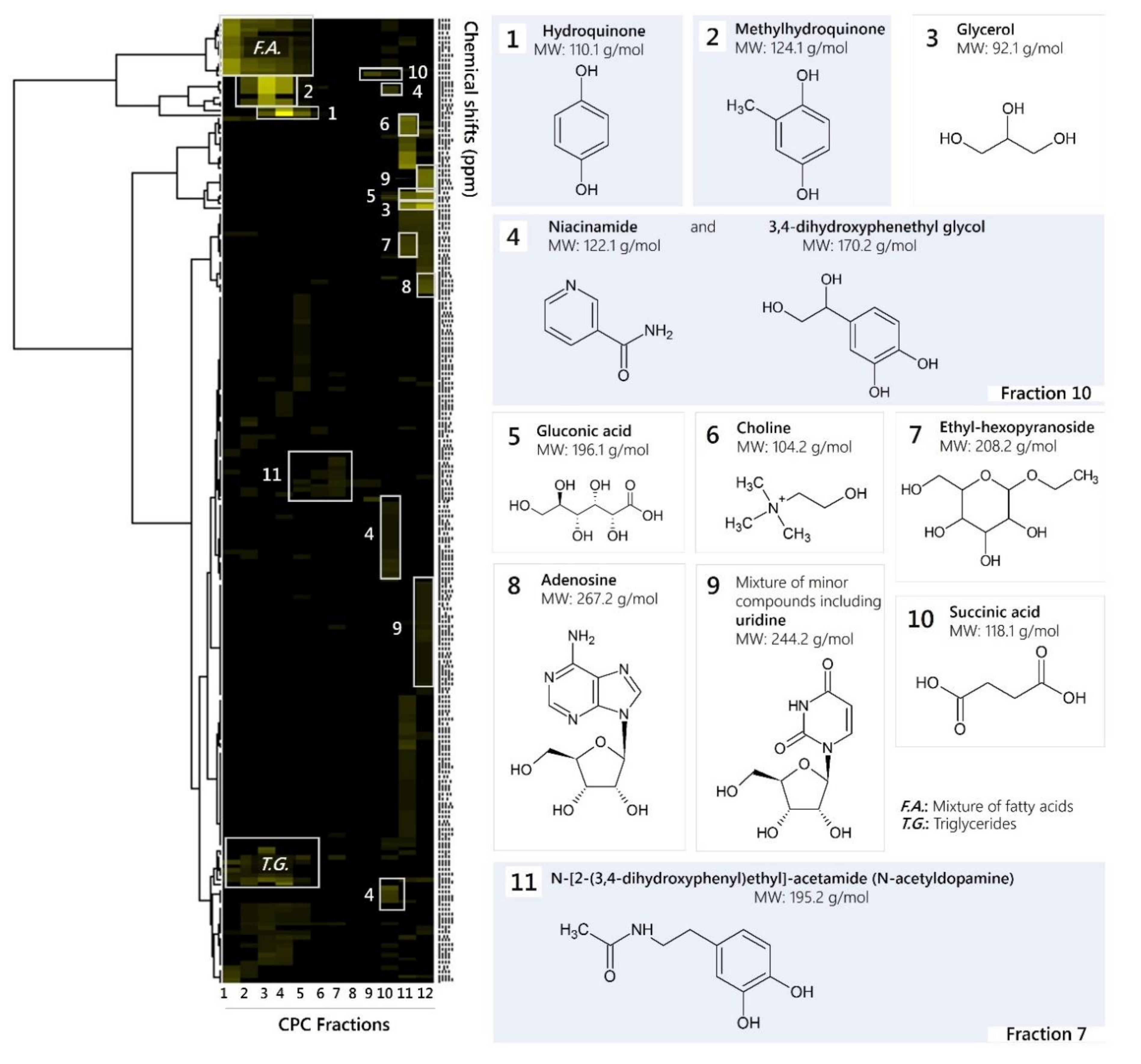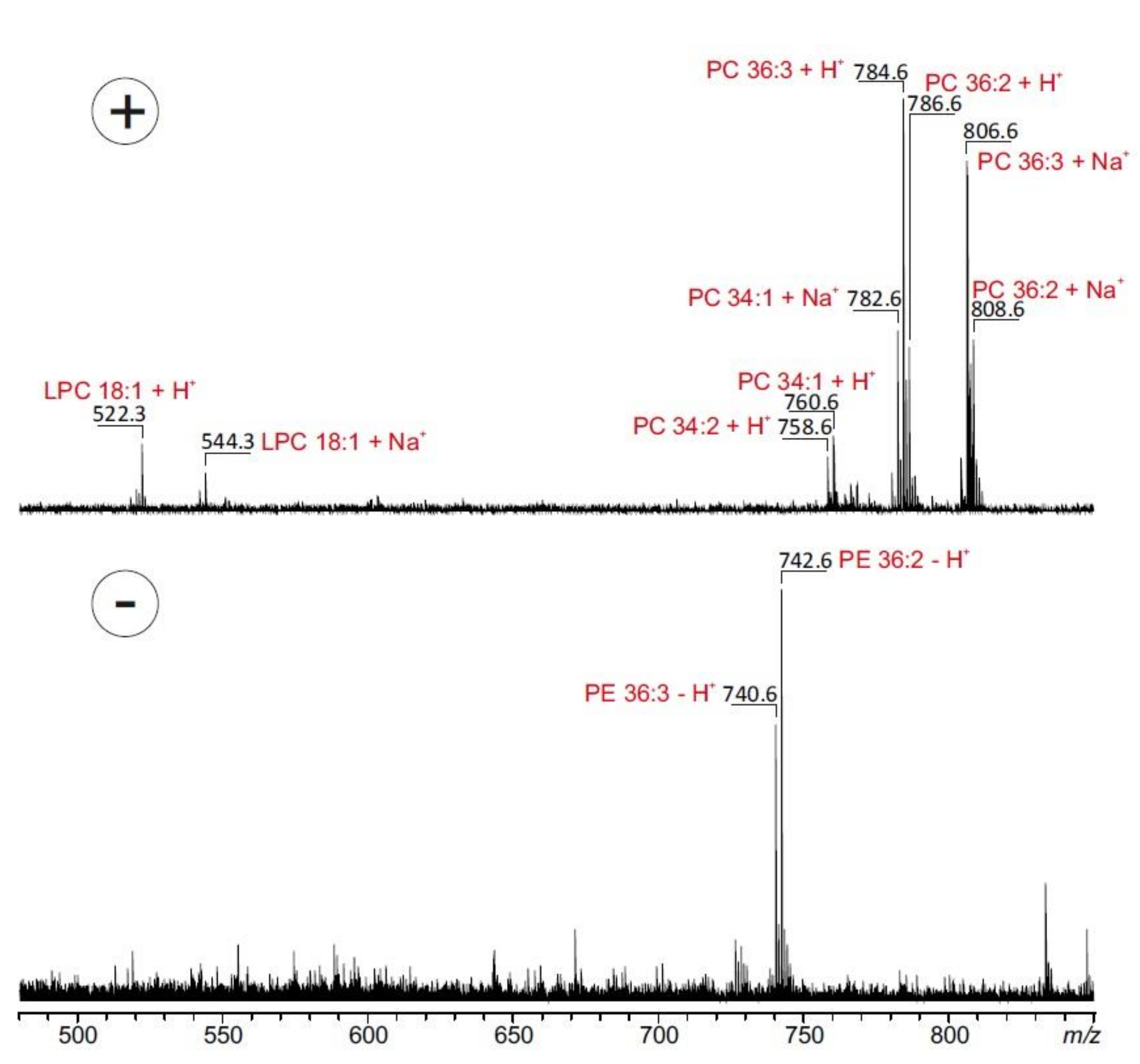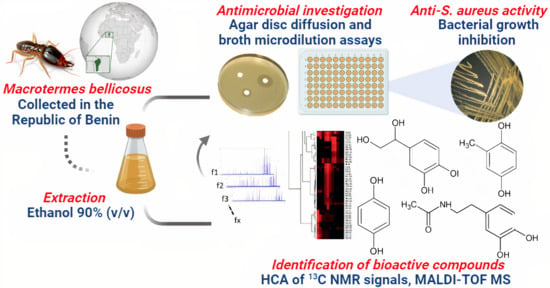Chemical Profile and Antimicrobial Activity of the Fungus-Growing Termite Strain Macrotermes Bellicosus Used in Traditional Medicine in the Republic of Benin
Abstract
1. Introduction
2. Results and Discussion
2.1. Chemical Profile
2.2. Antimicrobial Activity of Ethanolic M. bellicosus Extracts, Fractions and Major Compounds
3. Materials and Methods
3.1. Chemicals and Reagents
3.2. Termite Materials
3.3. Preparation of Termite Extracts
3.4. Chemical Profiling of M. bellicosus
3.4.1. Centrifugal Partition Chromatography
3.4.2. 13C-NMR Analyses and Data Processing
3.4.3. MALDI-TOF MS
3.5. Antimicrobial Testing
3.5.1. Microbiological Material
3.5.2. Kirby–Bauer Disc Diffusion Assay
3.5.3. Broth Microdilution Assay
3.5.4. Data Evaluation and Statistical Analysis
4. Conclusions
Supplementary Materials
Author Contributions
Funding
Acknowledgments
Conflicts of Interest
References
- Solavan, A.; Paulmurugan, R.; Wilsanand, V.; Sing, A.J. Traditional therapeutic uses of animals among tribal population of tamil nadu. Indian J. Tradit. Know. 2004, 3, 198–205. [Google Scholar]
- de Figueirêdo, R.E.C.R.; Vasconcellos, A.; Policarpo, I.S.; Alves, R.R.N. Edible and medicinal termites: A global overview. J. Ethnobiol. Ethnomed. 2015, 11, 29. [Google Scholar] [CrossRef] [PubMed]
- Loko, L.E.Y.; Orobiyi, A.; Agre, P.; Dansi, A.; Tamò, M.; Roisin, Y. Farmers’ perception of termites in agriculture production and their indigenous utilization in Northwest Benin. J. Ethnobiol. Ethnomed. 2017, 13, 64. [Google Scholar] [CrossRef] [PubMed]
- Hammoud Mahdi, D.; Wissenbach, D.K.; von Bergen, M.; Vissiennon, Z.; Chougourou, D.; Nieber, K.; Ahyi, V.; Vissiennon, C. Ethnomedicinal survey and in vitro confirmation of anti-inflammatory and antispasmodic properties of the termite strain Macrotermes bellicosus used in traditional medicine in the republic of Benin. J. Ethnopharmacol. 2020, 254, 112705. [Google Scholar] [CrossRef] [PubMed]
- Eggleton, P. Global diversity patterns. In Termites: Evolution, Sociality, Symbiosis, Ecology; Abe, T., Bignell, D.E., Higashi, M., Eds.; Kluwer Academic Publishers: Florida, FL, USA, 2000; pp. 25–51. [Google Scholar]
- Traniello, J.; Rosengaus, R.; Savoie, K. The development of immunity in a social insect: Evidence for the group facilitation of disease resistance. Proc. Natl. Acad. Sci. USA 2002, 99, 6838–6842. [Google Scholar] [CrossRef]
- Hubert, J.; Nuzillard, J.-M.; Purson, S.; Hamzaoui, M.; Borie, N.; Reynaud, R.; Renault, J.-H. Identification of natural metabolites in mixture: A pattern recognition strategy based on 13C NMR. Anal. Chem. 2014, 86, 2955–2962. [Google Scholar] [CrossRef] [PubMed]
- Adepoju, O.T.; Omotayo, O.A. Nutrient composition and potential contribution of winged termites (macrotermes bellicosus smeathman) to micronutrient intake of consumers in Nigeria. Br. J. Appl. Sci. Technol. 2014, 4, 1149. [Google Scholar] [CrossRef]
- Adepoju, O.T.; Ajayi, K. Nutrient composition and adequacy of two locally formulated winged termite (macrotermes bellicosus) enriched complementary foods. J. Food Res. 2016, 5, 79–89. [Google Scholar]
- Moore, B.P. Studies on the chemical composition and function of the cephalic gland secretion in Australian termites. J. Insect. Physiol. 1968, 14, 33–39. [Google Scholar] [CrossRef]
- Maschwitz, U.; Tho, Y.P. Chinone als Wehrsubstanzen bei einigen orientalischen Macrotermitinen. Insectes Soc. 1974, 21, 231–234. [Google Scholar] [CrossRef]
- Olagbemiro, T.O.; Lajide, L.; Sani, K.M.; and Staddon, B.W. 2-hydroxy-5-methyl-1,4-benzoquinone from the salivary gland of the soldier termites Odontotermes Magdalenae. Experientia 1988, 44, 1022–1024. [Google Scholar] [CrossRef]
- Gössinger, E. Progress in the Chemistry of Organic Natural Products; Chemistry of the Secondary Metabolites of Termites; Springer: Berlin/Heidelberg, Germany, 2019; Volume 109, pp. 1–384. [Google Scholar] [CrossRef]
- Sillam-Dussès, D.; Krasulová, J.; Vrkoslav, V.; Pytelková, J.; Cvačka, J.; Kutalová, K.; Bourguignon, T.; Miura, T.; Šobotník, J. Comparative study of the labial gland secretion in termites (Isoptera). PLoS ONE 2012, 7, e46431. [Google Scholar] [CrossRef] [PubMed]
- Sugumaran, M.; Saul, S.; Semensi, V. On the mechanism of formation of N-acetyldopamine quinone methide in insect cuticle. Arch. Insect Biochem. Physiol. 1998, 9, 269–281. [Google Scholar] [CrossRef]
- Karlson, P.; Sekeris, C.E. N-acetyldopamine as the sclerotizing agent of the insect cuticle. Nature 1962, 195, 183. [Google Scholar] [CrossRef]
- Herrera, H.; Barros-Parada, W.; Bergmann, J. Linoleic acid and stearic acid are biosynthetic precursors of (7Z,10Z)-7,10-hexadecadienal, the major component of the sex pheromone of Chilecomadia valdiviana (Lepidoptera: Cossidae). PLoS ONE 2019, 14, e0215769. [Google Scholar] [CrossRef]
- Abu, T.; Njoku-Onu, K.A.; Augustine, E.U. Classification, chemical composition and therapeutic properties of termite species- a review. Int. J. Community Res. 2017, 6, 70–80. [Google Scholar]
- Badanaro, F.; Houndji, B.V.S.; Melila, M.; Amevoin, K.; Amouzou, S.K.E. Nutritional potential of macrotermes bellicosus (smeathman, 1781) (isoptera: Termitidae), one of the most comercialized edible insects in Togo. J. Rech. Sci. Univ. Lomé 2018, 20, 41–50. [Google Scholar]
- Van Huis, A.; Van Itterbeeck, J.; Klunder, H.; Mertens, E.; Halloran, A.; Muir, G.; Vantomme, P. Edible Insects: Future Prospects for Food and Feed Security; FAO Forestry Paper 171; FAO: Rome, Italy, 2013. [Google Scholar]
- DeFoliart, G.R. Insect fatty acids: Similar to those of poultry and fish in their degree of unsaturation, but higher in the polyunsaturates. Food Insects Newsl. 1991, 4, 1–4. [Google Scholar]
- Khaliq, A.; Javed, M.; Sohail, M.; Sagheer, M. Environmental effects on insects and their population dynamics. J. Entomol. Zool. Stud. 2014, 2, 1–7. [Google Scholar]
- Fuller, C.A. Fungistatic activity of freshly killed termite, Nasutitermes acajutlae, soldiers in the Caribbean. J. Insect Sci. 2007, 7, 14. [Google Scholar] [CrossRef]
- Prestwich, G.D. Defense Mechanisms of Termites. Ann. Rev. Entomol. 1984, 29, 201. [Google Scholar] [CrossRef]
- Šobotník, J.; Jirošová, A.; Hanus, R. Chemical warfare in termites. J. Insect Physiol. 2010, 56, 1012–1021. [Google Scholar] [CrossRef] [PubMed]
- Kouakou, K.; Panda, S.K.; Yang, M.-R.; Lu, J.-G.; Jiang, Z.-H.; Puyvelde, L.; Van Luyten, W. Isolation of antimicrobial compounds from cnestis ferruginea vahl ex. Dc (connaraceae) leaves through bioassay-guided fractionation. Front. Microbiol. 2019, 10, 705. [Google Scholar] [CrossRef] [PubMed]
- Chang, H.M.; But, P.P.H. Pharmacology and Applications of Chinese Materia Medica; World Scientific Publishing, Co. Pte Ltd.: Singapore, 1987; Volume 2, pp. 825–828. [Google Scholar]
- Ma, C.; He, N.; Zhao, Y.; Xia, D.; Wei, J. Antimicrobial mechanism of Hydroquinone. Biotechnol. Appl. Biochem. 2019, 189. [Google Scholar] [CrossRef]
- Nalawade, T.M.; Bhat, K.; Sogi, S.H.P. Bactericidal activity of propylene glycol, glycerine, polyethylene glycol 400, and polyethylene glycol 1000 against selected microorganisms. J. Int. Soc. Prev. Community Dent. 2015, 5, 114–119. [Google Scholar] [CrossRef] [PubMed]
- Kaplancikli, Z.A.; Yurttaş, L.; Turan-Zitouni, G.; Özdemir, A.; Özic, R.; Ulusoylar-Yıldırım, Ş. Synthesis, antimicrobial activity and cytotoxicity of some new carbazole derivatives. J. Enzym. Inhib. Med. Chem. 2012, 27, 868–874. [Google Scholar] [CrossRef] [PubMed]
- Zhao, P.; Li, J.; Wang, Y.; Jiang, H. Broad-spectrum antimicrobial activity of the reactive compounds generated in vitro by Manduca sexta phenoloxidase. Insect Biochem. Mol. Biol 2007, 37, 952–959. [Google Scholar] [CrossRef] [PubMed]
- Amini, A.; Liu, M.; Ahmad, Z. Understanding the link between antimicrobial properties of dietary olive phenolics and bacterial ATP synthase. Int. J. Biol. Macromol. 2017, 101. [Google Scholar] [CrossRef] [PubMed]
- Mruthyunjaya, S.; Prathyusha, M.; Shilpa, V.; Vidula, I.; Jyoti, T.; Amit, C.; Amitabha, M. Niacinamide leave-on formulation provide long-lasting protection against bacteria in vivo. Exp. Derm. 2017, 26, 827–829. [Google Scholar] [CrossRef]
- Eisenhofer, G.; Ropchak, T.G.; Stull, R.W.; Goldstein, D.S.; Keiser, H.R.; Kopin, I.J. Dihydroxyphenylglycol and intraneuronal metabolism of endogenous and exogenous norepinephrine in the rat vas deferens. J. Pharm. Exp. 1987, 241, 547–553. [Google Scholar]
- Dilika, F.; Bremner, P.D.; Meyer, J. Antibacterial activity of linoleic and oleic acids isolated from Helichrysum pedunculatum: A plant used during circumcision rites. Fitoterapia 2000, 71, 450–452. [Google Scholar] [CrossRef]
- Siopa, F.; Figueiredo, T.; Frade, R.; Neto, Í.; Meirinhos, A.; Reis, C.; Sobral, R.; Afonso, C.; Rijo, P. Choline-Based Ionic Liquids: Improvement of Antimicrobial Activity. ChemistrySelect 2016, 1, 5909–5916. [Google Scholar] [CrossRef]
- Nieto, P.C.; Savino, J.; Bertini, E.; Sánchez, L.; Figueroa, L. Gluconic acid produced by Gluconacetobacter diazotrophicus Pal5 possesses antimicrobial properties. Res. Microbiol. 2014, 165, 549–558. [Google Scholar] [CrossRef] [PubMed]
- Volchegorskii, I.; Pravdin, E.V.; Pospelova, A.V.; Bakhareva, L.I.; Uzlova, T.V. Effect of 3-hydroxypyridine and succinic acid derivatives on bacterial growth in discontinuous cultures. Eksp. Klin. Farm. 2016, 79, 29–34. [Google Scholar]
- Kabir, A.; Matin, M.; Kawsar, S.M.A. Synthesis and antibacterial activities of some uridine derivatives. Chittagong Univ. J. Biol. Sci. 1998, 22, 13–18. [Google Scholar]
- Lai, P.S.; Bebell, L.M.; Meney, C.; Valeri, L.; White, M.C. Epidemiology of antibiotic-resistant wound infections from six countries in Africa. BMJ Glob. Health 2018, 2, e000475. [Google Scholar] [CrossRef]
- Baba-Moussa, L.; Anani, L.; Scheftel, J.M.; Couturier, M.; Riegel, P.; Haikou, N.; Hounsou, F.; Monteil, H.; Sanni, A.; Prévost, G. Virulence factors produced by strains of Staphylococcus aureus isolated from urinary tract infections. J. Hosp. Infect. 2008, 68, 32–38. [Google Scholar] [CrossRef]
- Baba-Moussa, L.; Ahissou, H.; Azokpota, P.; Assogba, B.; Atindéhou, M.M.; Anagonou, S.; Keller, D.; Sanni, A.; Prévost, G. Toxins and adhesion factors associated with Staphylococcus aureus strains isolated from diarrhoeal patients in Benin. Afr. J. Biotechnol. 2010, 9, 604–611. [Google Scholar]
- Baba-Moussa, L.; Ahoyo, T.A.; Le Brun, C.; Makoutodé, M.; Dramane, K.; Kotchoni, S.O.; Prévost, G. Nosocomial pneumonia associated to pvl-producing Staphylococcus aureus in children in Benin. ISRN Infect. 2013, 2013. [Google Scholar] [CrossRef]
- Sina, H.; Baba-Moussa, F.; Kayodé, A.P.; Noumavo, P.A.; Sezan, A.; Hounhouigan, J.D.; Kotchoni, S.O.; Prévost, G.; Baba-Moussa, L. Characterization of Staphylococcus aureus isolated from street foods: Toxin profile and prevalence of antibiotic resistance. J. Appl. Biosci. 2011, 46, 3133–3143. [Google Scholar]
- Solavan, A.; Paulmurugan, R.; Wilsanand, V. Antibacterial activity of subterranean termites used in South Indian folk medicine. Indian J. Tradit. Know. 2007, 6, 559–562. [Google Scholar]
- Bligh, E.G.; Dyer, W.J. A rapid method of total lipid extraction and purification. Can. J. Biochem. Physiol. 1959, 37, 911–917. [Google Scholar] [CrossRef]
- Schiller, J.; Arnhold, J.; Benard, S.; Müller, M.; Reichl, S.; Arnold, K. Lipid analysis by matrix-assisted laser desorption and ionization mass spectrometry: A methodological approach. Anal. Biochem. 1999, 267, 46–56. [Google Scholar] [CrossRef]
- Barry, A.L. Susceptibility tests: Diffusion test procedure. Man. Clin. Microbiol. 1985, 978–987. [Google Scholar]
- Wikler, M.A. Methods for Dilution Antimicrobial Susceptibility Tests for Bacteria that Grow Aerobically; M7-A7; CLSI: Wayne, PA, USA, 2006; Volume 26. [Google Scholar]



| CPC- Fractions Nº (Time in Minutes) | Mass (mg) | % Crude Extract | Composition |
|---|---|---|---|
| 1 (8–9) elution | 39.5 | 2.8 | Mixture of fatty acids among which linoleic acid (Maj) + oleic acid (Maj) + triglycerides (Min) |
| 2 (10) elution | 24.0 | 1.7 | MHQ (Maj) + mixture of fatty acids (Maj) + triglycerides + triglycerides (Med) |
| 3 (11) elution | 25.3 | 1.8 | HQ (Med) + MHQ (Maj) + mixture of fatty acids (Med) + triglycerides (Med) |
| 4 (12–13) elution | 24.6 | 1.7 | HQ (Maj) + MHQ (Med) + mixture of fatty acids (Min) |
| 5 (14–15) elution | 8.3 | 0.6 | HQ (Maj) + mixture of fatty acids (Min) |
| 6 (16–18) elution | 7.4 | 0.5 | HQ (Med) + NADA (Med) |
| 7 (19–21) elution | 7.5 | 0.5 | NADA (Maj) |
| 8 (22–25) elution | 4.8 | 0.3 | NADA (Maj) |
| 9 (26–28) elution | 5.6 | 0.4 | Succinic acid (Maj) |
| 10 (30–48) elution | 13.7 | 1.0 | DHPG (Maj) + niacinamide (Maj) + succinic acid (Maj) |
| 11 (49–50) extrusion | 892.4 | 63.7 | Glycerol (Med) + gluconic acid (Med) + choline (Maj) + ethyl hexopyranoside (Med) |
| 12 (52–fin) extrusion | 112.5 | 8.0 | Glycerol (Maj) + gluconic acid (Med) + adenosine (Med) + uridine (Min) |
| Inhibitory Zone Diameters IZD (mm) | |||||||
|---|---|---|---|---|---|---|---|
| Macrotermes bellicosus | AMX | ||||||
| 50 µg/disc | 100 µg/disc | 25 µg/disc | |||||
| MBEAB | MBESE | MBELO | MBEAB | MBESE | MBELO | ||
| S. aureus | 10 ± 0.3 * | 6 ± 0.2 * | 6 ± 0.6 * | 15 ± 0.2 * | 12 ± 0.4 * | 11 ± 0.2 * | 15 ± 0.4 * |
| E. coli | 6 ± 0.5 * | 5 ± 0.4 * | 4 ± 0.3 * | 8.5 ± 0.6 * | 8 ± 0.3 * | 7 ± 0.6 * | 13 ± 0.5 * |
| P. aeruginosa | 7 ± 0.6 * | 6 ± 0.3 * | 6.5 ± 0.2 * | 8 ± 0.3 * | 9 ± 0.5 * | 7 ± 0.3 * | 12 ± 0.2 * |
| K. pneumoniae | (-) | (-) | 4 ± 0.3 * | (-) | (-) | 6 ± 0.4 * | 12 ± 0.6 * |
| C. albicans | (-) | (-) | (-) | (-) | (-) | (-) | (-) |
| Site of Collection | GPS Coordinates | Species |
|---|---|---|
| Abomey-Calavi | 6°26′ N, 2°21′ E | Macrotermes bellicosus, Smeathman 1781 |
| Sekou | 6°37′ N, 2°13′ E | Macrotermes bellicosus, Smeathman 1781 |
| Lokossa | 6°38′ N, 1°43′ E | Macrotermes bellicosus, Smeathman 1781 |
Sample Availability: Samples of the compounds are available from the authors. |
Publisher’s Note: MDPI stays neutral with regard to jurisdictional claims in published maps and institutional affiliations. |
© 2020 by the authors. Licensee MDPI, Basel, Switzerland. This article is an open access article distributed under the terms and conditions of the Creative Commons Attribution (CC BY) license (http://creativecommons.org/licenses/by/4.0/).
Share and Cite
Hammoud Mahdi, D.; Hubert, J.; Renault, J.-H.; Martinez, A.; Schubert, A.; Engel, K.M.; Koudogbo, B.; Vissiennon, Z.; Ahyi, V.; Nieber, K.; et al. Chemical Profile and Antimicrobial Activity of the Fungus-Growing Termite Strain Macrotermes Bellicosus Used in Traditional Medicine in the Republic of Benin. Molecules 2020, 25, 5015. https://doi.org/10.3390/molecules25215015
Hammoud Mahdi D, Hubert J, Renault J-H, Martinez A, Schubert A, Engel KM, Koudogbo B, Vissiennon Z, Ahyi V, Nieber K, et al. Chemical Profile and Antimicrobial Activity of the Fungus-Growing Termite Strain Macrotermes Bellicosus Used in Traditional Medicine in the Republic of Benin. Molecules. 2020; 25(21):5015. https://doi.org/10.3390/molecules25215015
Chicago/Turabian StyleHammoud Mahdi, Dima, Jane Hubert, Jean-Hugues Renault, Agathe Martinez, Andreas Schubert, Kathrin Monika Engel, Blaise Koudogbo, Zacharie Vissiennon, Virgile Ahyi, Karen Nieber, and et al. 2020. "Chemical Profile and Antimicrobial Activity of the Fungus-Growing Termite Strain Macrotermes Bellicosus Used in Traditional Medicine in the Republic of Benin" Molecules 25, no. 21: 5015. https://doi.org/10.3390/molecules25215015
APA StyleHammoud Mahdi, D., Hubert, J., Renault, J.-H., Martinez, A., Schubert, A., Engel, K. M., Koudogbo, B., Vissiennon, Z., Ahyi, V., Nieber, K., & Vissiennon, C. (2020). Chemical Profile and Antimicrobial Activity of the Fungus-Growing Termite Strain Macrotermes Bellicosus Used in Traditional Medicine in the Republic of Benin. Molecules, 25(21), 5015. https://doi.org/10.3390/molecules25215015







